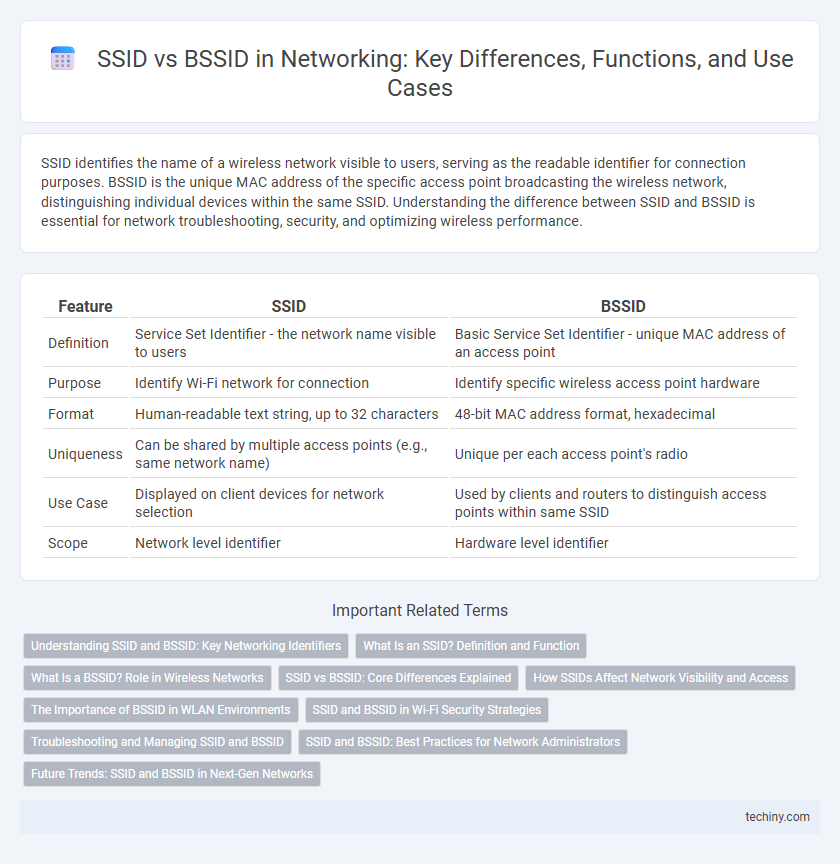SSID identifies the name of a wireless network visible to users, serving as the readable identifier for connection purposes. BSSID is the unique MAC address of the specific access point broadcasting the wireless network, distinguishing individual devices within the same SSID. Understanding the difference between SSID and BSSID is essential for network troubleshooting, security, and optimizing wireless performance.
Table of Comparison
| Feature | SSID | BSSID |
|---|---|---|
| Definition | Service Set Identifier - the network name visible to users | Basic Service Set Identifier - unique MAC address of an access point |
| Purpose | Identify Wi-Fi network for connection | Identify specific wireless access point hardware |
| Format | Human-readable text string, up to 32 characters | 48-bit MAC address format, hexadecimal |
| Uniqueness | Can be shared by multiple access points (e.g., same network name) | Unique per each access point's radio |
| Use Case | Displayed on client devices for network selection | Used by clients and routers to distinguish access points within same SSID |
| Scope | Network level identifier | Hardware level identifier |
Understanding SSID and BSSID: Key Networking Identifiers
SSID (Service Set Identifier) is the name of a wireless network, serving as a human-readable identifier that allows devices to recognize and connect to a specific Wi-Fi network. BSSID (Basic Service Set Identifier) is the unique MAC address of the wireless access point that provides the network, distinguishing multiple access points under the same SSID in environments like enterprise networks. Understanding the distinction between SSID and BSSID is essential for network management, enabling precise identification of networks and their individual access points for optimized connectivity and troubleshooting.
What Is an SSID? Definition and Function
An SSID (Service Set Identifier) is a unique name assigned to a wireless network that allows devices to identify and connect to the correct Wi-Fi network. It functions as the broadcast identifier for wireless access points, enabling users to distinguish between multiple networks within the same area. Unlike the BSSID, which is the MAC address of the specific access point hardware, the SSID represents the network name visible to all users.
What Is a BSSID? Role in Wireless Networks
A BSSID (Basic Service Set Identifier) uniquely identifies each access point within a wireless network, typically represented as a MAC address. Unlike the SSID, which is a user-friendly network name broadcast by routers, the BSSID ensures precise communication between devices and specific access points. In Wi-Fi networks, the BSSID is crucial for devices to connect to the correct access point in environments with multiple overlapping SSIDs.
SSID vs BSSID: Core Differences Explained
SSID represents the human-readable network name broadcasted by wireless access points, enabling users to identify and connect to the desired Wi-Fi network. BSSID is the unique MAC address assigned to each individual access point or wireless router, distinguishing multiple devices within the same SSID. While the SSID groups multiple access points under a common network name for seamless roaming, the BSSID ensures precise identification of each physical access point for network management and connection stability.
How SSIDs Affect Network Visibility and Access
SSID (Service Set Identifier) broadcasts the network name, making Wi-Fi networks visible to devices and users within range, which directly impacts network accessibility. Hidden SSIDs reduce network visibility to casual users but do not secure the network effectively, as determined attackers can still detect and connect using tools. Proper SSID configuration, combined with strong encryption like WPA3, enhances both network discoverability for legitimate users and overall wireless security.
The Importance of BSSID in WLAN Environments
BSSID, or Basic Service Set Identifier, uniquely identifies each access point in a WLAN, ensuring precise device-to-access point communication that improves network efficiency and reduces interference. Unlike the SSID, which is a common network name shared by multiple access points, the BSSID is a distinct MAC address that enables clients to select the optimal access point based on signal strength and quality. Accurate use of BSSID is crucial for seamless roaming, load balancing, and enhanced security in dense wireless environments.
SSID and BSSID in Wi-Fi Security Strategies
SSID (Service Set Identifier) serves as the public network name broadcasted by Wi-Fi access points to identify the wireless network to users. BSSID (Basic Service Set Identifier) refers to the unique MAC address assigned to each access point's radio interface, enabling precise identification and management within a network. Implementing security strategies, such as hiding SSIDs and monitoring BSSIDs, helps prevent unauthorized access by reducing network visibility and tracking suspicious devices in Wi-Fi environments.
Troubleshooting and Managing SSID and BSSID
Troubleshooting wireless networks often involves distinguishing between SSID and BSSID to identify connection issues accurately. SSID represents the network name broadcasted by multiple access points, while BSSID is the unique MAC address of a specific access point, crucial for pinpointing device-level problems. Managing SSID and BSSID effectively enhances network performance by facilitating targeted configuration and interference resolution.
SSID and BSSID: Best Practices for Network Administrators
Network administrators should prioritize using unique SSIDs to clearly identify and manage wireless networks, improving user connectivity and minimizing interference. BSSID, which corresponds to the MAC address of each wireless access point, is essential for precise network monitoring, troubleshooting, and ensuring secure client associations. Implementing standardized SSID naming conventions alongside BSSID tracking enhances network organization and optimizes performance in complex environments.
Future Trends: SSID and BSSID in Next-Gen Networks
Next-gen networks increasingly leverage dynamic SSID management to enhance user experience by enabling seamless roaming and optimized network segmentation, while BSSID plays a critical role in precise device localization and interference reduction through advanced beamforming techniques. The integration of AI-driven algorithms allows SSID broadcasting patterns to adapt in real-time, improving security and bandwidth allocation in dense environments. Future wireless infrastructures will rely on synergistic SSID-BSSID coordination to support ultra-low latency applications and massive IoT deployments in 5G and Wi-Fi 7 ecosystems.
SSID vs BSSID Infographic

 techiny.com
techiny.com